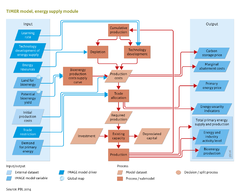Energy supply: Difference between revisions
No edit summary |
(Text edits) |
||
| (54 intermediate revisions by 6 users not shown) | |||
| Line 1: | Line 1: | ||
{{ComponentTemplate2 | {{ComponentTemplate2 | ||
| | |Application=Roads from Rio+20 (2012) project; ADVANCE project; | ||
|IMAGEComponent=Drivers; Land cover and land use; Crops and grass; Climate policy; Atmospheric composition and climate; | |||
|KeyReference=De Vries et al., 2007; Van Vuuren et al., 2008; Van Vuuren et al., 2009; | |||
|InputVar=Technology development of energy supply; Energy resources; Trade restriction; Demand for primary energy; Potential bioenergy yield - grid; Land supply for bioenergy - grid; Learning rate; | |||
|Parameter=Initial production costs; | |||
|OutputVar=Primary energy price; Carbon storage price; Energy security indicators; Total primary energy supply; Marginal abatement cost; Energy and industry activity level; Bioenergy production; | |||
|ComponentCode=ES | |ComponentCode=ES | ||
| | |AggregatedComponent=Energy supply and demand | ||
|FrameworkElementType=pressure component | |||
|FrameworkElementType= | |||
}} | }} | ||
<div class="page_standard"> | |||
The energy supply model simulates long-term trends in energy supply. This model describes the investments in, and the use of, different types of energy carriers by technology development and resource depletion. Technological development is implemented in form of learning curves for most fuels and renewable energy options. Costs decrease endogenously as a function of the cumulative energy capacity. On the other hand, resource costs increase as they get depleted which is based on cost-supply curves. | |||
Energy supply is assumed to always meet energy demand. In order to do so, not only domestic resources can be used, but energy carriers, such as coal, oil and gas, can also be traded. The impact of depletion and technology development lead to changes in primary fuel prices, which influence investment decisions in the end-use and energy-conversion modules. Linkages to other parts of IMAGE framework include available land for bio-energy production and emissions of greenhouse gases and air pollutants. | |||
{{InputOutputParameterTemplate}} | |||
</div> | |||
Latest revision as of 10:19, 21 October 2021
| Component is implemented in: |
|
| Related IMAGE components |
| Projects/Applications |
| Key publications |
Key policy issues
- How can energy resources be exploited to meet future primary energy demand?
- How can energy supply and demand be balanced between world regions, and how will this effect security of supply?
- How rapidly can the transition to more sustainable energy supply be made?
Introduction
The energy supply model simulates long-term trends in energy supply. This model describes the investments in, and the use of, different types of energy carriers by technology development and resource depletion. Technological development is implemented in form of learning curves for most fuels and renewable energy options. Costs decrease endogenously as a function of the cumulative energy capacity. On the other hand, resource costs increase as they get depleted which is based on cost-supply curves.
Energy supply is assumed to always meet energy demand. In order to do so, not only domestic resources can be used, but energy carriers, such as coal, oil and gas, can also be traded. The impact of depletion and technology development lead to changes in primary fuel prices, which influence investment decisions in the end-use and energy-conversion modules. Linkages to other parts of IMAGE framework include available land for bio-energy production and emissions of greenhouse gases and air pollutants.
Input/Output Table
Input Energy supply component
| IMAGE model drivers and variables | Description | Source |
|---|---|---|
| Technology development of energy supply | Learning curves and exogenous learning that determine technology development. | Drivers |
| Learning rate | Determines the rate of technology development in learning equations. | Drivers |
| Energy resources | Volume of energy resource per carrier, region and supply cost class (determines depletion dynamics). | Drivers |
| Trade restriction | Trade tariffs and barriers limiting trade in energy carriers (in energy submodel). | Drivers |
| Demand for primary energy | Total demand for energy production. Sum of final energy demand and energy inputs into energy conversion processes. | Energy conversion |
| Potential bioenergy yield - grid | Potential yields of bioenergy crops. | Crops and grass |
| Land supply for bioenergy - grid | Land available for sustainable bioenergy production (abandoned agricultural land and non-forested land). | Land cover and land use |
| External datasets | Description | Source |
|---|---|---|
| Initial production costs | The costs of energy conversion technologies at the start of the simulation. | Various sources |
Output Energy supply component
| IMAGE model variables | Description | Use |
|---|---|---|
| Marginal abatement cost | Cost of an additional unit of pollution abated (CO2eq). A marginal abatement cost curve (MAC curve) is a set of options available to an economy to reduce pollution, ranked from the lowest to highest additional costs. | |
| Bioenergy production | Total bioenergy production. | |
| Energy and industry activity level | Activity levels in the energy and industrial sector, per process and energy carrier, for example, the combustion of petrol for transport or the production of crude oil. | |
| Primary energy price | The price of primary energy carriers based on production costs. | |
| Carbon storage price | The costs of capturing and storing CO2, affecting the use of CCS technology. | |
| Energy security indicators | Indicators on the status of energy security, such as energy self-sufficiency. | Final output |
| Total primary energy supply | Total primary energy supply. | Final output |
